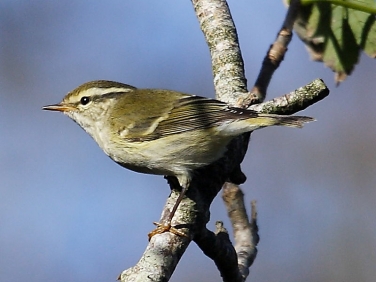All the well known coastal birding valleys seem to have them along with Firecrests. It seems that in these wooded areas if you find tit flocks and Goldcrests there is a good chance of there being both Firecrests and Yellow-browed Warblers close by.
Last year I had the amazing experienced seeing at least four Yellow-browed Warblers plus Firecrests at Carnon Down Sewage works all in one small section of hedge. This sewage works with its abundant insect life seems to be a magnet for winter warblers and so maybe it will be again this year.
The Yellow-barred Warbler is only between 9 and 10.5 cms in length making it only slightly larger than the smallest British birds, the Goldcrest and Firecrest. And because of its diminutive size and habit of flitting energetically amongst leaves it is almost certainly under recorded. It wouldn’t be surprising if the actual number of these tiny warblers presently in Cornwall runs in to the hundreds and, possibly, even thousands.
Identification of the Yellow-barred Warbler (latin name Phylloscopus inornatus) is usually relatively easy given reasonable views. The yellow stripe above its eye and lack of golden crest readily identify it from the more common Goldcrest (Regulus regulus) and Firecrest (Regulus ignicapillus).
The rarer Pallas’s Warbler (Phylloscopus proregulus) has a yellow central crown stripe, yellow rump and the yellow stripe above its eye is more heavily outlined in black. Separating it from the rare Hume’s Leaf Warbler (Phylloscopus humei) is more problematic as the subtle colour variations of various features are very difficult to conclusively determine in the field. In exceptional light and viewing conditions the Hume’s shows darker legs, paler cheeks, greyer back, paler grey centres to tertials and coverts and an all black bill. Experienced birders familiarise themselves with the different calls of the Yellow-browed and Hume’s to be certain of identification.
Related pages: Bird posts | British birds gallery
Reference: Collins Bird Guide.

Leave a Reply
You must be logged in to post a comment.